The History Of Nissan Quest

The Nissan Quest is a minivan produced by Nissan since 1993. There have been three generations of this model. The first generation Quest was a collaboration with Ford, which marketed a rebadged variant as the Mercury Villager. The vans debuted at the 1992 North American International Auto Show in Detroit.
Both vehicles were initially powered by the 3.0 L Nissan VG30E V6 until 1999, when the Quest received the 3.3 L version of the same engine. The Quest was completely redesigned for 2004, while the Villager was discontinued and replaced with the Freestar-based Mercury Monterey. The current model is built on the FF-L platform, which it shares with the Altima, Maxima, and Murano. It also shares the award-winning 3.5 L VQ engine with those cars.
First generation (1993-1998)
The Nissan Quest was a new model made by Nissan to compete in the minivan segment. The Quest was a successor to the Axxess, which was sold in the United States in 1990 only and in Canada from 1990-1995. It also replaced the rear-wheel drive Vanette, also discontinued in 1990. The Quest was initially powered by Nissan's 3.0 L VG30E SOHC engine that made 151 hp and 182 ft·lb. Ford required that Nissan make some design changes to the VG30E before they would agree to use it in the Villager and Quest. One of the requirements from Ford was that the engine was to be modified to become a non-interference or free-running engine. (Thus if the timing belt breaks, there would be no damage to the valves). Other changes included the addition of an oil level sensor and relocating the oil filter assembly for better access. The Quest was available as XE or GXE models. Because of manufacturing issues, Nissan had an arrangement for Ford to assemble the minivan in North America, and in turn they were allowed to rebadge it and sell it under the Mercury brand as the Villager. Many of the interior parts, including the radio, heater controls and power windows controls were adapted from Ford, and were similar to the Ford Aerostar. This generation of the Quest minivan was built in Avon Lake, Ohio, where the Villager was also built. The van shared the modified version of the VG30E from the U11, and early J30 Maximas, as well as the 4-speed automatic transmission from the Maxima.
The Quest is distinguishable from the Mercury Villager by a grille and headlights that are slightly shorter top to bottom than those on the Villager.
Seating was for 7, with a removable 2-seater bench in the middle, allowing the third row bench of 3 seats to slide up (either folded up for more room or down for passengers) behind the front for more rear cargo room. 1996 saw the introduction of changes to the front and rear fascias, as well as headlights and tail lamps. 1996 was also the first year for the driver's side airbag- which eliminated the motorized shoulder belts.
Second generation (1999-2002)
For 1999, the Quest was redesigned, and it gave the exterior a more aerodynamic look, and the driver's side sliding door. The Quest also got a power boost via the 3.3 L VG33E SOHC engine, making 171hp (128kW) and 200lb·ft (270N·m) of torque. The XE trim was discontinued and the GXE was moved as the base model. Two new trim levels were also introduced: the top of the line GLE and the sport model SE.
Nissan imbued the 2001 Quest with a raft of minor improvements. Styling front and rear was updated, along with new alloy wheels on all models. The entry-level GXE gained a rear stabilizer bar, while the SE received acceleration-sensitive strut valving and a strut tower brace. New interior gauges and fabrics as well as a 130-watt sound system were standard on SE and GLE. Luxury GLE models also received an in-dash six-CD changer and a wood and leather-trimmed steering wheel. An optional overhead family entertainment system replaced the former floor-mounted model, though it could still be specified for SEs and GLEs equipped with a sunroof. Front seatbelts were given pretensioners. The 2001 Quest was also slightly longer, with more cargo space than the previous generation. The 2002 Nissan Quest was not sold in Canada. The Quest would not return to Canada until the third generation model arrived in 2004.
By the end of this generation, both Honda and Toyota marketed soley long-wheelbase minivans. No Quest models were marketed for the 2003 model year.
Third generation (2004-present)
After the 2002 discontinuation of the Mercury Villager, the third generation Quest was redesigned for the 2004 model year using the previous-generation Nissan Altima and Nissan Maxima platform in a package slightly longer than the Chrysler long-wheelbase minivans. Production moved to Canton, Mississippi.
The Quest is powered by the oft-used 3.5 L VQ35DE engine from the Maxima, Altima, and others. In the Quest, it produces 240hp (179kW) and 242lb·ft (328N·m) of torque. The Quest has a flat folding rear bench and the two middle chairs fold nearly flat into the floor. The interior volume is 211.9 ft³.
The third generation Quest features an unusual moonroof glass arrangement, and positions for 2 DVD screens. Nissan redesigned the front grille and the dashboard for the 2007 model.
Price Pricing for 2006:
- Base MSRP: $24,150
- S Special Edition MSRP: $25,450
- SL MSRP: $27,050
- SE MSRP: $33,650
Sale Figures
2003 - 23,170 (From remaining 2002 & 2004 model early sales)
2004 - 46,430
2005 - 40,357
2006 - 31,905
2007 - 28,590
2008 - 3,200 (as of July 1, 2008)
From Wikipedia, the free encyclopedia
More About Nissan Quest
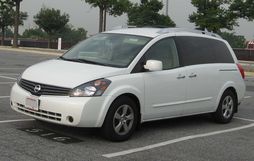
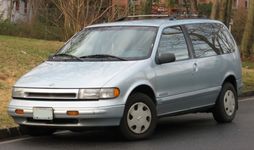
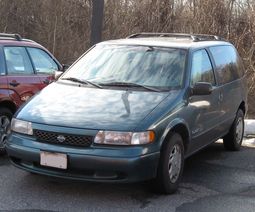
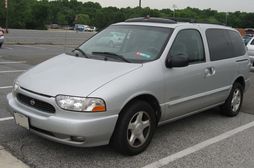

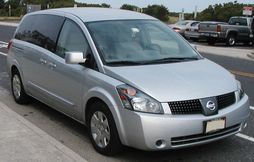
|